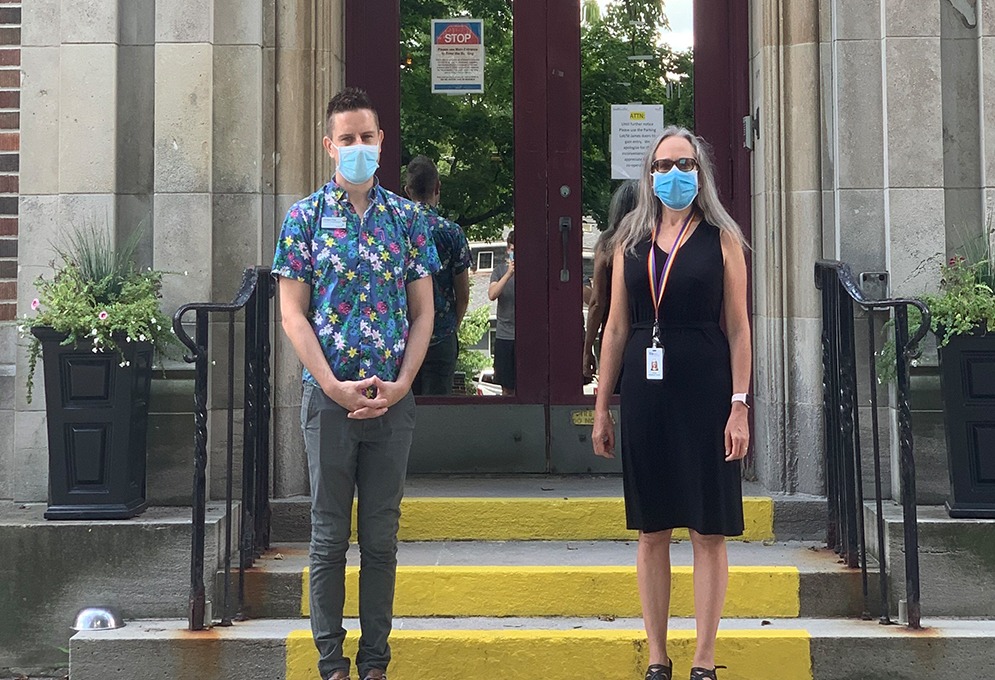Creativity and Collaboration Optimizing Virtual Care Services for VHA’s London Rehab Team

COVID-19 has made virtual care services available across many parts of our health care system and it’s clear that this shift that isn’t going anywhere. For rehab therapists at VHA Home HealthCare in London, their virtual care success stories have been driven by new partnerships, creative work and a willingness to embrace change, that will help them continue to provide client-centred care throughout the pandemic and beyond.
When Amanda Selk, occupational therapist and Clinical Leader at VHA received referrals from a retirement home that was hit hard by COVID-19, virtual care was the only option for her clients at risk. “Navigating hearing impairments, language barriers, mobility challenges and technology access issues during the initial telephone assessments made it quite clear that virtual care would be challenging to implement with this client population,” said Amanda. “After originally feeling discouraged, I asked facility management if anyone could help me connect with clients from the inside and I was immediately directed to Jordan Fox, a recreational therapist whose regular duties were naturally impacted by the outbreak.”
Amanda and Jordan formed an unlikely partnership in which Jordan—in full personal protective equipment—facilitated the occupational therapy sessions in-person. He would move the camera around the room to help Amanda better understand the environment, find the right camera angle for each aspect of care and repeat instructions if there were any hearing issues or language barriers.
“From the very beginning Jordan went above and beyond to support residents in a scary and high-risk environment. With his help, I was able to reach our therapeutic goals and develop surprisingly strong connections with my clients through a screen,” said Amanda. “Physical distancing doesn’t have to get in the way of collaboration—in this case two organizations worked together in an unexpected way to ensure that vulnerable residents were cared for during a crisis.”
Amanda now sees virtual care services as a new and valuable tool in her toolbox that she will continue to use outside of pandemic times. “I welcome more options and increased flexibility for home care clients. And for retirement homes I think there’s an opportunity to continue partnerships like this one and to include substitute decision-makers and family in their loved ones’ care—whether they are separated by lockdown or just geography,” she said.
For Claudia Everling, a physiotherapist at VHA in London, it was hard to go into these uncertain times without reservations. “Early on in the pandemic, I was skeptical about virtual care and I know service providers and their clients all had their doubts. Physiotherapy is just so hands-on and it was hard to see how this could be translated in a virtual way,” said Claudia.
Claudia’s perspective really started to change when she was caring for a post-operative client after a hip replacement. Before all of the details around security, confidentiality and consent for video conferencing were finalized, Claudia’s only way to provide care for this client was by phone—which was limiting for many reasons. To meet these challenges, Claudia started making videos of herself doing stabilizing exercises and emailing them securely to her client. “It was pretty awkward to watch myself,” she laughed. “But I started to notice how effective these videos were—even when we moved to video conferencing—as a reminder of the work to do between visits and as a way to encourage our therapeutic connection. Especially when I was able be in-person again with my client and saw how well the videos translated into his space and I could clearly see the functional gains he had made,” said Claudia.
“Virtual care on its own can be restrictive, but there’s a lot of creative work happening and I’m excited to see how a hybrid model of care will complement and improve the quality of services moving forward,” she said. “There’s a steep learning curve and a lot of hurdles, but I’m not the youngest person on my team. I keep saying that if I can do this, I know anyone can.”
To learn more about virtual care services at VHA and to see if they might be right for you, visit www.vha.ca/virtual-care/.
